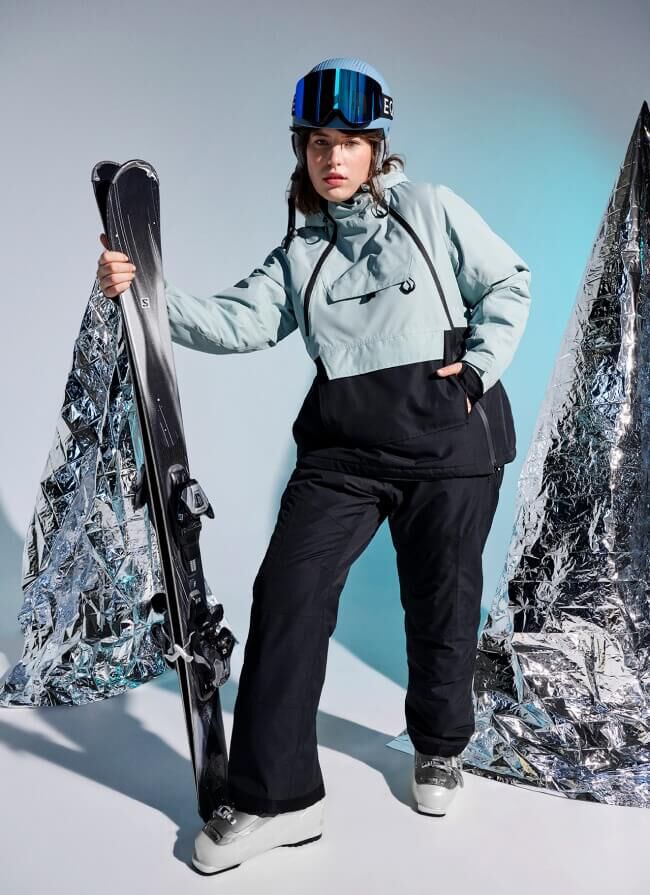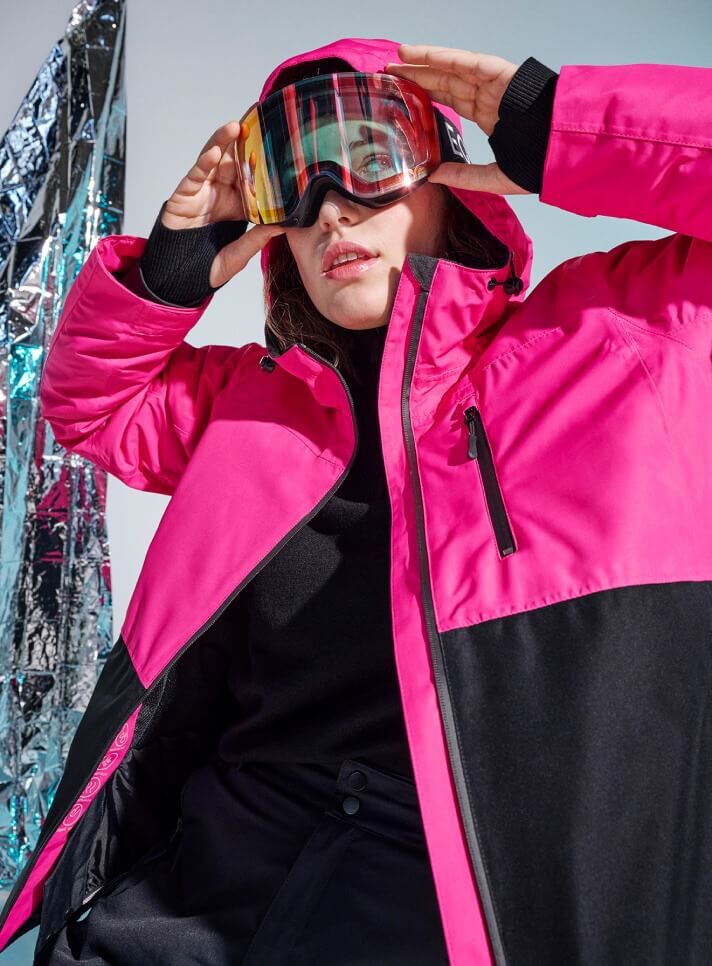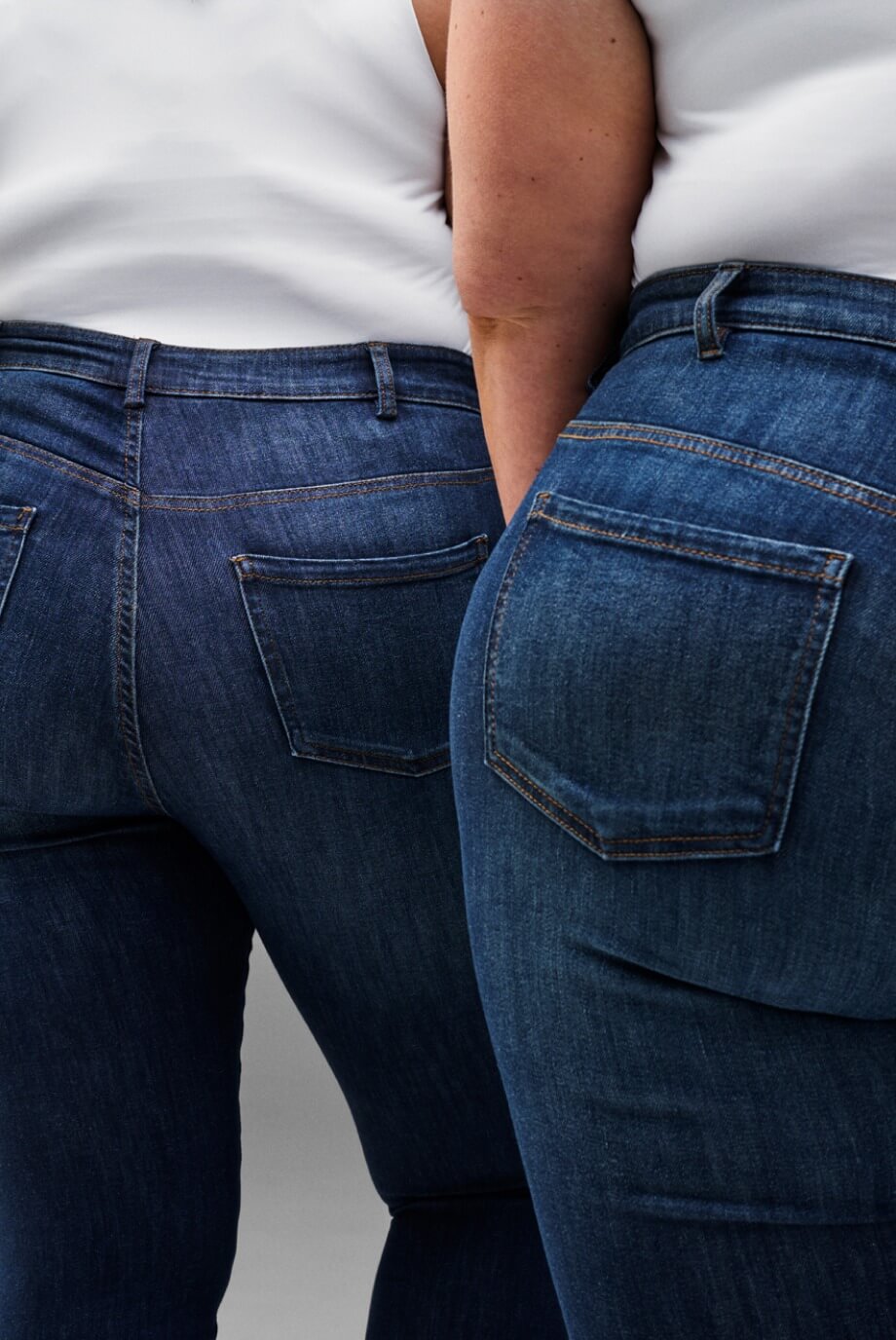
How to choose the right ski jacket
Perhaps you’ve never tried skiing before, or maybe you’re an accomplished skier. Regardless of which level you’re at, it’s important to have the right ski wear when you’re out on snow covered mountains. We’ll help you figure out what you should be aware of when you’re looking for the perfect ski jacket in a plus size.
Which ski jacket should you choose?
In order to figure out which plus-size ski jacket you should choose, you’ll need to figure out what you’ll be using it for. This means dressing for the activity and purpose. You should also consider which features you need most in terms of pockets, waterproofing, a hood etc.
Your activity level plays an important role in your choice of jacket. If you’re planning on a leisurely walk or a rest day outdoors, your jacket will need to be spacious and warm. If, on the other hand, you’re going to be active, such as going hiking up and down mountains, it’s important that the jacket is lightweight and breathable.
Two popular jackets for the slopes
You should note that there are different types of jackets. When it comes to ski jackets, there are two that are most common. The first is the classic women's ski jacket, which is typically a thicker jacket with a lining. The second popular jacket is the shell jacket, which is thinner.
Read more below as we take a closer look at features, benefits and tips for choosing the best women's ski jacket.
The classic ski jacket
The ski jacket, also called the padded ski jacket, is the most common. It is a warm ski jacket for women, which can be used for a normal skiing holiday. It meets the most common needs and therefore it will be the safest choice. If you go skiing a few times a year, or if you just like being out in the cold, you should choose this ski jacket.
13 features of the ski jacket
It can be hard to know what to look for when choosing your new women's ski jacket. Below, we'll go through the features of a ski jacket to help you understand its benefits.
1. Breathability: a ski jacket has good breathability, but typically not as much as a shell jacket. This is one of the reasons why the ski jacket is best suited for those who stick to the more leisurely or typical ski trips.
2. Waterproof: in addition to keeping you warm, one of the most important functions of a ski jacket is to keep you dry. To find out how waterproof the jacket is, the water column pressure is measured in mm, and as a general rule, the water column pressure of a ski jacket must be at least 5,000-8,000 mm before it is water-repellent enough to be used as a ski jacket.
3. Wind resistance: when you're moving around in the mountains and snow, you need a ski jacket with good wind resistance. And luckily, most of them do. The jacket needs to be able to withstand the cold weather so you can stay out for long periods without getting cold.
4. Taped seams: The vast majority of ski jackets have taped seams. Although the holes made by the sewing machine are very small, they are large enough to allow water to pass through. Taped seams ensure that water does not get in anywhere.
5. Adjustable details: Your ski jacket should be able to keep out snow and wind. Therefore, it should also have adjustable components at all openings - neck, bottom and sleeves. This can be in the form of elastic or velcro.
6. Practical pockets: make sure your ski jacket has good pockets and that they are easy to handle even with gloves on. And the position of the pockets can also be important. For example, many ski jackets have a small pocket for the lift pass on the sleeve, so it's easy to scan the pass.
7. High collar: A high collar can help keep out the cold. That's why ski jackets usually have one. It's best if you can adjust the width of it so you can avoid getting cold on your neck.
8. Armpit ventilation: a good ski jacket can keep you warm, but if you come back from a trip to the slopes where your body got too hot, you may need to air out a bit. That's why our ski jackets have zips in the armpits, so you can adjust the ventilation as you like.
9. Detachable hood: If you're just going to enjoy a quiet day in the snow, you may not need a big hood. For those days, it's good to be able to detach the hood and use a knitted hat or ear warmers instead.
10. Wind protection in the sleeves: our ski jackets have windproof elastic closures with thumb holes in the sleeves. This allows you to fasten your sleeves tightly, but still be able to use your hands.
11. Inner lining: ski jackets are often lined on the inside. This helps one of the jacket's most important functions, which is to keep you warm. Often the lining is made of fleece, which is both soft and warm.
12. Snow cover: A good ski jacket has a snow flap, which is an extra piece of fabric sewn to the inside of the bottom of the jacket. The snow flap is closed with press studs and has an elasticated edge at the bottom to prevent wind and snow from getting under the jacket.
13. Reflectors: although the snow is white, the surroundings can be dark when the sun is away. That's why it's a good idea for your ski jacket to have reflectors to ensure you can be seen when you're out in the open.
Your activity level plays an important role in your choice of jacket
The versatile shell jacket
If you're an active skier, you'll probably need a shell jacket rather than a warm ski jacket. A shell jacket for women is thinner, but also more breathable. In addition, the jacket itself is lighter. So, it's for those who don't need a warm jacket, but who get warm by being active.
8 features of the shell jacket
There are several features to look out for when choosing your women's shell jacket. This will help you decide if this is the jacket you should go for. Get an overview of shell jacket features below.
1. Breathability: because the shell jacket is good for you as an active skier, it must also be breathable. When you're being active, you sweat more, and your body needs to be able to breathe. This is possible with a shell jacket that has high breathability.
2. Waterproof: the higher the water column pressure, the lower the risk of getting wet. Our shell jacket has a water resistance of 10,000 mm, so you can wear it safely when you're active in the snow.
3. Wind resistance: although you might get warm if you're an active skier, your shell jacket still needs to be able to shield you from the cold weather. That's why shell jackets usually have good wind proofing, which allows you to focus on your skiing instead of the cold.
4. Taped seams: Taped seams keep water out, which is why our shell jacket has taped seams in places where water is likely to penetrate - including the zips.
5. Adjustable fastenings: to make sure that snow, rain, and other things don't get under the jacket, it should have adjustable fastenings at the sleeves, bottom, and neck. This way, you can also better adjust the fit so that it sits comfortably on you.
6. Practical pockets: when you're going to be out for a long time, you need a place for the essentials. That's why your shell jacket should have enough pockets, and preferably lots of them. After all, if you don't use them, they don't take up space, so it doesn't hurt to have plenty of pockets.
7. High collar: It's not always practical to wear a scarf when you're skiing. That's why you can go for a jacket with a high collar that you can adjust and close all the way when you want to keep the cold at bay.
8. Reflectors: reflectors are always a good thing. Especially if you're out at the beginning or end of the day, when it might be a bit dark. That's why our shell jackets have reflective details, so you can be sure of being seen.
What should you wear underneath a ski jacket?
The best option is to dress in layers – three layers to be precise: ski thermals in the form of an undershirt and trousers as the base layer; a middle layer that can be, for example, a fleece or knit; and the outer and final layers are your ski jacket and ski trousers.
It's called the three-layer principle, and with three layers you're guaranteed to stay warm all day. At the same time, you can adapt to the weather throughout the day, because you can constantly adjust by adding or removing a layer. Below you can see what the different layers do.
The inner layer - sweat wicking
It's always a good idea to wear a ski base layer as the inner layer under your ski suit. It is made of a material that is thin and can wick away sweat. And that's exactly what the inner layer should do.
The middle layer - insulating
Your mid-layer should be able to keep you warm while allowing your body to breathe. For example, you could choose a wool, knit or fleece jumper. That way you can stay warm and still move.
The outer layer - wind and waterproof
Your women's ski jacket is the final and outermost layer. Whichever jacket you go for, it needs to be functional, warm and wind and waterproof. It's there to protect you from the elements.
Don’t forget about ski trousers
If you’re looking for ski jackets, you’ll often also need a pair of high-quality, plus-size ski trousers. With ski trousers, you’ll generally need to look out for the same features as with ski jackets: waterproofness, taped seams, breathability, etc.
As with the ski suit, ski trousers allow you to show your personal style, for example by choosing your colour. Not only are colourful ski jackets and ski trousers great to look at, but they also have the added benefit of making you easier to find if you have an accident or get separated from your friends.
Accessories for skiing
Accessories are also a great way to add even more personality to your ski look. For example, wrapping up in a gorgeous scarf or ski hat will keep you warm around the ears. Ski gloves are also essential, whether you’re going out on a longer walk or just spectating.
With the right plus-size ski jacket for women, a pair of functional ski trousers as well as some accessories, you’re ready to spend an entire day out in the snow.





































